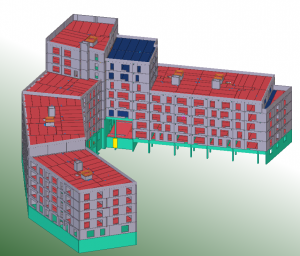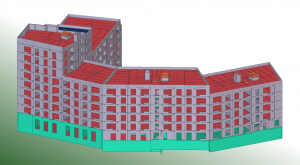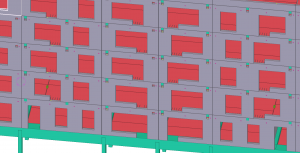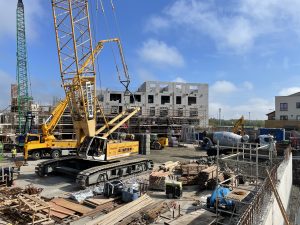 Câștigătorul categoriei pe țări:
Câștigătorul categoriei pe țări:
Hampton Wood

| Categoria | Proiecte comerciale |
|---|---|
| Anul | 2021 |
| Țara | Poland |
| Organizația | Precast spółka z o.o. |
| Parteneri de proiect | N/A |
| Autor | Precast spółka z o.o. |
| Coautori | N/A |
| Client | N/A |
| Locația construcției | Dublin |
| Tags |
Obiekt stanowi ostatni etap inwestycji Hampton Wood – osiedla mieszkaniowego zlokalizowanego w Dublinie (Irlandia), składającego się z 19 bloków. Budowę pierwszego z nich rozpoczęto w 2004r.
W skład obiektu budowlanego, posiadającego roboczą nazwę CELL 16, wchodzi 5 bloków zapewniających łącznie 135 jednostek mieszkalnych. Niemal każdy blok został zaprojektowany jako niezależna konstrukcja, oddylatowana od reszty obiektu. Nieszablonowe rozmieszczenie obiektu na planie działki oraz zastosowanie różnej ilości pięter w zależności od bloku (budynek liczy od 6 do 10 pięter) stworzyło finalnie unikalny i niepowtarzalny wygląd inwestycji.
W obiekcie zastosowano połączenie konstrukcji monolitycznej z konstrukcją prefabrykowaną. Przygotowany model BIM spełnił kluczową rolę w spotkaniach koordynacyjnych pomiędzy projektantami poszczególnych części budynków. Bliskie sąsiedztwo elementów prefabrykowanych z elementami konstrukcji monolitycznej nierzadko stanowiło również wyzwanie dla kadry inżynierskiej nadzorującej wznoszenie budynku. Niewielkie błędy popełnione przy przygotowaniu konstrukcji monolitycznej zostały z łatwością wychwycone oraz naprawione przy użyciu modelu BIM. Warto wspomnieć, iż model ten stanowił podstawę organizacji pracy montażystów elementów prefabrykowanych. Komunikacja oraz aktualizowanie modelu BIM konstrukcji prowadzone było przy użyciu platformy CDE Trimble Connect.
Największym wyzwaniem projektowym było spełnienie wymagań Architekta dotyczących układu otworów elewacyjnych (otwory drzwiowe, okienne, wentylacyjne, otwory w miejscu łączenia podkonstrukcji balkonów do stropów). Unikalny wygląd obiektu został dopełniony poprzez nieregularny układ elewacji. Zespół projektantów zmuszony był do stosowania bardzo różnorodnych rozwiązań konstrukcyjnych w celu zapewnienia odpowiedniej nośności oraz stabilności pojedynczych elementów jak i całego obiektu.
The building object is the last stage of the Hampton Wood investment –a housing settlement located in Dublin (Ireland) , which consists of 19 apartment buildings. The construction of the first one started in 2004.
Cell 16 is a working name for mentioned building object, which includes 5 blocks providing in total 135 housing units. Approximately each block was designed as an independent structure with an extension joint in between, with other part of the building object. The unconventional arrangement of the object on the plot plan, and the use of a different number of floors, depends on the block, provides the unique appearance of the investment.
A design of the objects uses a combination of the monolithic structure and a precast structure. Prepared BIM model played a key role in the coordination meetings, between a design team. The team consists of designers and engineers who take care of specified part of the design. The integration of the precast elements and monolithic construction, was not an uncommon challange for the construction site engineering staff, who supervised a rising of the construction. Minor errors made during designing of a monolithic structure were instantly caught and revised using a BIM model. It is significant to mention that the BIM model was also used as a basis for the work arrangement of the assemblers of the precast elements. Communication and actualization of the BIM model was carried out by a platform CDE Trimble Connect usage.
The most challenging part of the design was the provision of architects’ requirements. The requirements concerned the arrangement of the elevation openings. In this case that were; window openings, door openings, vents, openings located in the joint between balcony substructure and precast panel floor. The unique appearance of the building was filled according to the irregular layout of the elevation. The design team was obliged to use a variety of construction solutions. Moreover, their aim was to provide an adequate load-bearing capacity and stability of particular elements of structure and the entire building as well.
 Câștigătorul categoriei pe țări:
Câștigătorul categoriei pe țări:











